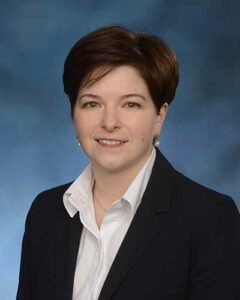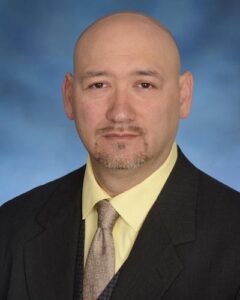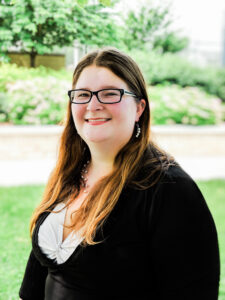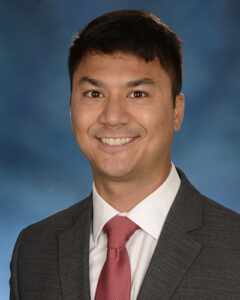APTAMD is highlighting the impactful work, diverse career paths and varied professional specialties of our members. through member spotlights.
 Dr. Cara Felter has been inspiring members through advocacy, education, patient care and practice innovation.
Dr. Cara Felter has been inspiring members through advocacy, education, patient care and practice innovation.
Dr. Felter is currently Director for Educational Affairs for the Doctor of Physical Therapy (DPT) Program at the University of Maryland School of Medicine Physical Therapy Program.
Prior to joining PTRS, she was a Physical Therapist at Kennedy Krieger Institute.
What I learned from being at Kennedy Krieger: When a patient comes to the team with the problem, the team’s role is to teach them how to achieve that goal. Sometimes, the patient will verbalize a very direct, short term goal. Other times, it’s the team’s job to help break down a long term goal into manageable short term goals to keep the patient motivated and engaged in the rehab process. If the long term goal is to get dressed independently, short term gains of strength, ROM, and learning appropriate strategies will be needed. At Kennedy Krieger we were fortunate to have the newest technologies and equipment to make those goals a reality for our patients. The result of a great team and access to innovative technology was a positive and hopeful environment for the patients, through which so much was possible.
Why did you pursue academia as a career path? After more than nine years of working at Kennedy Krieger, I can take my experience and knowledge to the future of our profession. I am sharing the message of what is possible when technological advancement and a positive atmosphere come together for the patients’ benefit. Knowing how much the patients were able to achieve in that environment, I’m excited to let the students know the incredible impact they can have. Our field is changing rapidly and our patients can benefit immensely from the scientific advances of this time. With a solid education, and a hopeful outlook, the students will be able to improve countless lives. I can’t wait to be a part of that process.
What do you enjoy about working with students? I love it when we are working on a new skill or concept in lab and the student has that lightbulb moment when they grasp the information. Sometimes it’s that look of confidence when they perform a new physical skill like popping a wheelie. Other times, it’s the moment they connect two critical pieces of information. To me, its that moment that brings them one step closer to becoming an analytical, autonomous therapist!
Cara has served on the APTA of Maryland Board of Directors as Secretary, was named an APTA Emerging Leader in 2009, received the Henry O and Florence P Kendall Award in 2018, and is currently a member of the DEI and continuing education committees.
Thank you Cara for your dedication to the profession!
 Dr. Film is the Program Director for the University School of Medicine (USOM) Fellowship in Orthopaedic Manual Physical Therapy; Academic Director for the University of Maryland Orthopaedic Physical Therapy Residency Program; and, Assistant Professor at the UMSOM Department of Physical Therapy & Rehabilitation Science (PTRS) where he teaches primarily in the areas of orthopedic PT, manual therapy, chronic pain, and evidence-based practice.
Dr. Film is the Program Director for the University School of Medicine (USOM) Fellowship in Orthopaedic Manual Physical Therapy; Academic Director for the University of Maryland Orthopaedic Physical Therapy Residency Program; and, Assistant Professor at the UMSOM Department of Physical Therapy & Rehabilitation Science (PTRS) where he teaches primarily in the areas of orthopedic PT, manual therapy, chronic pain, and evidence-based practice.
What made you decide to go in to physical therapy? Before I knew what a physical therapist did, many of my friends were telling me that I should become a physical therapist. At the time, I had just completed the pre-med program at NYU but was very disenchanted with a future in medicine as pressures on physicians were forcing them to spend very little time with their patients even in the mid-1990s. I wanted to spend time with patients to help them regain function abilities they had lost. My friends all told me that it sounded like I would be interested in physical therapy. Once I looked into the profession, I realized they were right. It was everything I wanted in a profession. I completed observation hours in multiple clinical settings all over New York City, started applying to physical therapy programs, and withdrew my applications to medical school.
What other certifications/degrees do you have?…What pulled you in that direction? I completed residency training in 2005 and manual therapy fellowship training in 2006, so I was very lucky to have gotten involved pretty early in post-professional clinical training. I became the second fellowship-trained PT in Maryland after Michael Caruso. I did things a bit backwards and took the Orthopaedic Clinical Specialist (OCS) exam after completing fellowship training, which was common back then.
Prior to that, I had been working at Magee Rehab in Philadelphia in the spinal cord injury setting. Although it was extremely rewarding to work in neurorehabilitation, the lack of control I had in helping patients achieve a significant level of neurological return frustrated me. I also had a few patients that I had worked with for many months who unexpectedly passed away within a short span of time and I realized I wasn’t really well-suited to handling that type of work-related stress. Ultimately, I gravitated towards manual therapy for the same reason a lot of therapists do – I felt like I was able to help my patients effectively return to their premorbid level of function, which was the primary reason I had entered the profession in the first place.
What rewards did you receive but not necessarily expect by being a physical therapist? Physical therapists tend to be pretty personable, so being a member has become a real part of my social circle. For me, membership has led to professional opportunities as well as lifelong friendships. It has led to a real connection with others in the profession, both locally and nationally.
I’ve been a member for so long because it’s absolutely worth it. Please read the rest of this response if you aren’t in complete agreement! I’ve heard several practicing PTs and several of my old classmates complain over the years that the annual cost of membership wasn’t worth it because they felt the APTA wasn’t doing enough for them. At first I agreed with them even though I had no actual knowledge of the impact of the APTA.
Then I realized that these therapists aren’t aware of all the benefits they enjoy because of the work of everyone involved in the APTA. Unfortunately, people who don’t understand these very significant benefits would have little desire to become a part of the APTA. I was very lucky to be around therapists who were obviously energized by their participation in the APTA and I gradually got involved over the course of several years.
I believe the vast majority of PTs are not aware how much work the APTA has done for them at both the state and national levels. One obvious example is that patients would not have direct access to our services if not for the efforts of thousands of PTs – and I mean that literally – over several decades. It took the work of all those PTs over all those years in every corner of the country to overcome monumental opposition and bias to finally realize direct access throughout the entire country. What they achieved was nothing short of a culture change – and that is one of the most difficult things to undertake. Attaining direct access has greatly benefitted every single practicing PT whether or not they are a member by increasing demand for our services. Over the course of decades, this has led to upward pressure on salaries throughout our profession in all clinical settings.
Recently, I presented at a multidisciplinary health professions summit in Washington, DC. I was very proud to hear effusive praise of the effectiveness of the APTA and our national efforts from representatives from a variety of national organizations including the American Chiropractic Association, the American Psychological Association, the National Hispanic Medical Association, the American Nurses Association, American Association of Nurse Practitioners, and the American Association of Nurse Anesthestists. Those outside our profession easily recognize the great work the APTA is doing. I wanted to become a part of a proud organization that does great things for its members and their patients and to help them see the great benefits of membership.
 Are you from this area originally?
Are you from this area originally?
I grew up on the Eastern Shore of Maryland and moved to the Baltimore area for Undergrad at UMBC. I have stayed in the Baltimore area ever since.
What made you decide to go in to physical therapy? I did a volunteer program at UMBC call MS Swim where we went to a local YMCA and got in the pool with people with MS. We completed resistance and stretching exercises with them and I fell in love with the interactions. I did that program all four years at UMBC. This program lead me to look more into physical therapy as a career and when I did, I fell in love with it.
What other certifications/degrees do you have?…What pulled you in that direction? I have a Bachelors of Science in Biochemistry with a minor in Psychology that I chose because I enjoyed Biology and Chemistry in highschool and I enjoyed the psychology courses I took my first year.
I am a Neurological Clinical Specialist. I love treating the neurological population and in my current position it is all I see. I wanted to demonstrate expertise.
I am a Certified Visceral Techniques Practitioner. After talking to a friend who has been a physical therapist for over 40 years, this technique is what she reported has been the most useful with treating difficult patients and was the missing link. I took the courses and pursed my certification through the Barral Institute. I use the techniques used with my patients regularly.
What rewards did you receive but not necessarily expect by being a physical therapist? All of the people I have met have been rewarding. Both co-workers and patients alike. I have meet many wonderful people who have taught me a great deal about many things.
Why did you seek out a position with the Board of Examiners? I wanted to see another side of physical therapy. I wanted to be able to be part of current policy and shaping PT for the future in the state of Maryland.
 Dr. Zarro is Assistant Professor at the Department of Physical Therapy & Rehabilitation Science at the University of Maryland Baltimore. He teaches in the human anatomy, biomechanics, and musculoskeletal content within the program with a focus on sport and exercise rehabilitation. He serves as a clinical instructor for DPT students on their clinical experiences. He currently serves as team physical therapist for the University of Maryland Terrapins and previously served as team physical therapist for Loyola University Maryland Greyhounds. He also volunteers with the local running and strength and conditioning community as well as United States Olympic Committee.
Dr. Zarro is Assistant Professor at the Department of Physical Therapy & Rehabilitation Science at the University of Maryland Baltimore. He teaches in the human anatomy, biomechanics, and musculoskeletal content within the program with a focus on sport and exercise rehabilitation. He serves as a clinical instructor for DPT students on their clinical experiences. He currently serves as team physical therapist for the University of Maryland Terrapins and previously served as team physical therapist for Loyola University Maryland Greyhounds. He also volunteers with the local running and strength and conditioning community as well as United States Olympic Committee.
Are you from this area originally?
Yes, I grew up in Bowie, Maryland.
hat made you decide to go in to physical therapy? I always had a strong interest in health related fields. I shadowed a variety of providers in the heath and fitness industry during high school and college and found that physical therapy best combined my interests in rehabilitation, health, exercise, and wellness.
What other certifications/degrees do you have?…What pulled you in that direction? I have additional training as a Board Certified Sports Clinical Specialist and Certified Strength and Conditioning Specialist and have taken various courses in dry needling, joint manipulation, and sports rehabilitation. These courses have helped me improve my understanding of athletic injuries and their rehabilitation approaches.
What rewards did you receive but not necessarily expect by being a physical therapist? Supporting the recovery of my patients’ provides a level of job satisfaction and personal reward that I never imagined.
Why is it Important for you to be a member of APTA and the Maryland Chapter? It is important to be a member of the Chapter and National APTA in order to participate in our profession’s overall goals
© 2025 APTA Maryland. All Rights Reserved.
APTA MARYLAND